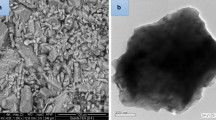Abstract
Carbon powder waste (CPW) obtained from the cutting process of laminate carbon composites, can be used to improve the strength and toughness of traditional cement-based building materials. Therefore, although the addition of CPW may influence the properties of the cement-based material, it is not clear how this influence works, and what are the optimum amount and fibre type in order not to have a negative impact on the new material. For these reasons, an experimental evaluation of the influence of recycled CPW addition on the physical and mechanical properties of reinforced cement pastes has been developed in this paper. With these purposes, seven different cement paste mixtures, with the same water/cement ratio, but with two different recycled CPW, and four different percentages have been evaluated. Based on the results, the decrease of compressive strength and abrasion resistance was attributed to the higher porosity of the cement paste caused by the CPW presence, while the flexural strength improvement could be attributed to good fibre distribution achieved into the cement pastes. Finally it was found that the type and amount of recycled CPW added in the cement pastes did not have a clear influence on the mechanical properties and abrasion resistance of the cement paste.












Similar content being viewed by others
References
Pickering SJ (2006) Recycling technologies for thermoset composite materials-current status. Compos Part A 37(8):1206–1215
Khale D, Chaudhary R (2007) Mechanism of geopolymerization and factors influencing its development: a review. J Mater Sci 42:729–746
Feih S, Boiocchi E, Mathys G, Mathys Z, Gibson AG, Mouritz AP (2011) Mechanical properties of thermally-treated and recycled glass fibres. Compos Part B 42(3):350–358
Thomas C, Borges PHR, Panzera TH, Cimentada A, Lombillo I (2014) Epoxy composites containing CFRP powder wastes. Compos Part B 59:260–268
Yang Y, Boom R, Irion B, van Heerden D, Kuiper P, de Wit H (2012) Recycling of composite materials. Chem Eng Process Process Intensif 51:53–68
Palmer J, Ghita OR, Savage L, Evans KE (2009) Successful closed-loop recycling of thermoset composites. Compos Part A 40(4):490–498
Sivarkumar A, Santhaman M (2007) Mechanical properties of high strength concrete reinforced with metallic and non-methalic fibres. Cement Concrete Comp 29(8):603–608
ACI Committe 544 (1973) State of the art Report on fiber reinforced concrete. ACI Journal 70:729–744
Cwirzen A, Habermehl-Cwirzen K (2013) The effect of carbon nano and microfibers on strength and residual cumulative strain of mortars subjected to freeze-thaw cycles. J Adv Mater 11(3):80–88
Reis JML, Ferreira AJM (2006) Freeze thaw and thermal degradation influence on the fracture properties of carbon and glass fiber reinforced polymer concrete. Constr Build Mater 20:888–892
Song PS, Hwan S, Sheu BC (2005) Strength properties of nylon and polypropylene fiber reinforced concretes. Cement Concrete Res 35:1546–1550
Chung DDL (2000) Cement reinforced with short carbon fibers: a multifunctional material. Compos Part B 31:511–526
SHRP-ID, UFR-92-605 (1992) Carbon fibre reinforced concrete. Department of Mechanical and Aerospace Engineering, State University of New York, Buffalo
Çavdar A (2014) Investigation of freeze-thaw effects on mechanical properties of fiber reinforced cement mortars. Compos Part B 58:463–472
Delaleux F, Py X, Olives R, Dominguez A (2012) Enhancement of geothermal borehole heat exchangers performances by improvement of bentonite grouts conductivity. Appl Therm Eng 33–34(1):92–99
Lee C, Lee K, Choi H, Choi HP (2010) Characteristics of thermally-enhanced bentonite grouts for geothermal heat exchanger in South Korea. Sci China Technol Sci 53:123–128
UNE-EN 197-1 (2000) Cement. Part 1: Composition, Specifications and Conformity Criteria for Common Cements. Asociación Española de Normalización y Certificación (AENOR)
EN 196–3:2005 + A1:2009 (2009) Methods of testing cement—Part 3: Determination of setting times and soundness. CEN European Committee for Standardization, Brussels
UNE-EN 1015-10 (2007) Methods of test for mortar masonry. Part 10: Determination of dry bulk density of hardened mortar. Asociación Española de Normalización y Certificación (AENOR)
UNE-EN 1015-11 (2007) Methods of test for mortar for masonry. Part 11: Determination of flexural and compressive strength of hardened mortar. Asociación Española de Normalización y Certificación (AENOR)
EN 14617–4 (2012) Agglomerated stone—test methods—part 4: determination of the abrasion resistance. CEN European Committee for Standardization, Brussels
Graham R, Huang B, Shu X, Burdette E (2013) Laboratory evaluation of tensile strength and energy absorbing properties of cement mortar reinforced with micro and mesosized carbon fibers. Constr Build Mater 44:751–756
Chen X, Wu S, Zhou J (2013) Influence of porosity on compressive and tensile strength of cement mortar. Constr Build Mater 40:869–874
Borinaga-Treviño R, Pascual-Muñoz P, Calzada-Pérez MA, Castro-Fresno D (2014) Freeze-thaw durability of cement-based geothermal grouting materials. Constr Build Mater 55:390–397
García A, Norambuena-Contreras J, Partl MN (2014) A parametric study on the influence of steel wool fibers in dense asphalt concrete. Mater Struct 47(9):1559–1571
Acknowledgments
The first author wish to thank the company Carbontek S.L. and the Laboratory of the Science and Engineering of Materials (LADICIM) for the financial support for his postdoctoral research developed at the Department of Science and Engineering of Ground and Materials of the University of Cantabria.
Author information
Authors and Affiliations
Corresponding author
Rights and permissions
About this article
Cite this article
Norambuena-Contreras, J., Thomas, C., Borinaga-Treviño, R. et al. Influence of recycled carbon powder waste addition on the physical and mechanical properties of cement pastes. Mater Struct 49, 5147–5159 (2016). https://doi.org/10.1617/s11527-016-0850-4
Received:
Accepted:
Published:
Issue Date:
DOI: https://doi.org/10.1617/s11527-016-0850-4




